

|


|
|
1/10 Scale Electric Buggy:
Mugen Bulldog AWDS
|
Introduced by Mugen circa 1985, the Four Wheel Drive, Four Wheel Steer Bulldog AWDS buggy, is belt driven, on a fabricated alloy plate and plastic chassis, with three ball differentials, front and rear mono air dampers, anti roll bars, dogbone drive-shafts and came with a roll cage, mechanical speed controller and 540 motor.
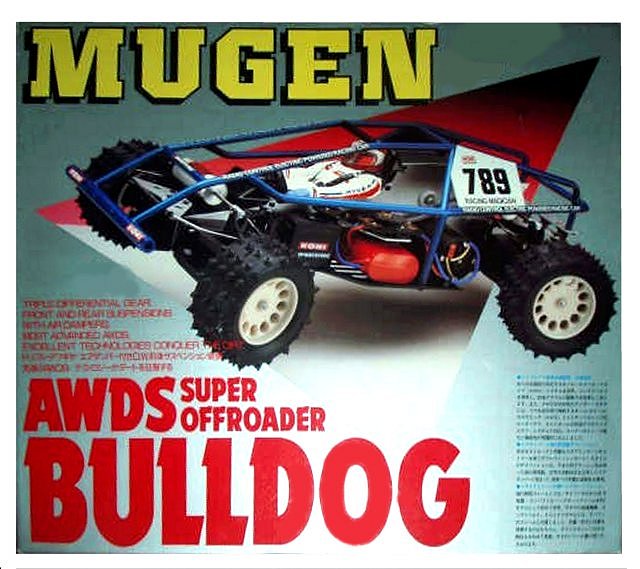
To race the Mugen Bulldog, it must be fine tuned to improve handling, provide responsive steering and give you the grip to cruise around corners at high speed, without slipping off the track. Small adjustments can make a Big difference and our step by step procedure, will guide you to the best Set-up for your individual driving style.








|
|
|

★ Mugen Bulldog AWDS ★
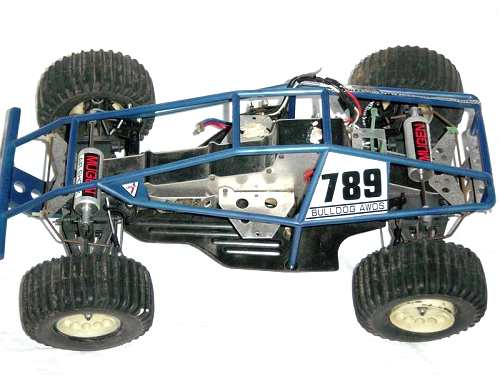
★ Mugen Bulldog AWDS Chassis ★
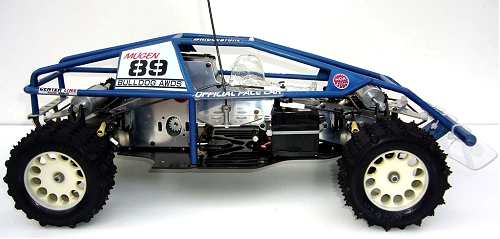
★ Mugen Bulldog AWDS Chassis ★
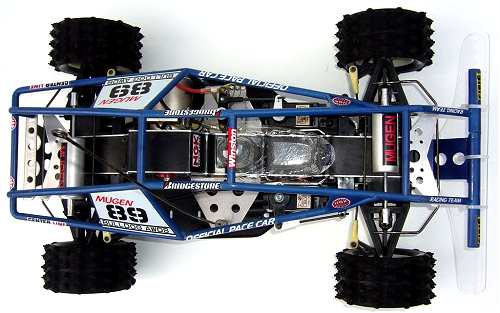
★ Mugen Bulldog AWDS Chassis ★
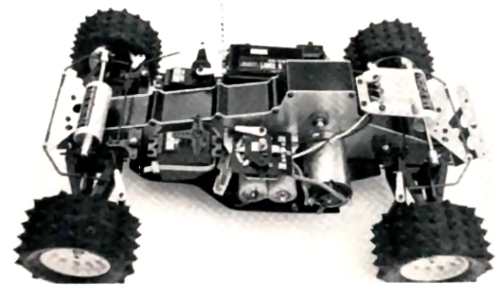
|
Buying a Used Mugen Bulldog Buggy (and What to look for)
Make a General Visual Inspection
Check the Body-Shell
If the body shell of your Mugen Bulldog is broken, ripped or damaged in any way, this can be easily repaired with rubber solution glue. Also, for added protection and if available for your Bulldog model, fit an under guard to stop dirt and gravel entering the chassis. Drive Shafts and Turnbuckles
Examine the Drive System
Drive Belts need checking at regular intervals for wear, tension and damage. If deemed necessary, adjust the tensioning pulley until the belt can be depressed in the centre by no more than around 5mm. If the belt was slack, also examine the drive pulleys for wear. The teeth should provide a well seated fit for the belt teeth and not be rounded on the corners. If the belt teeth do not fit snugly, change the pulleys as soon as possible. For top level racing it may be prudent to replace all belts and pulleys after each race meeting. Pinions and Spur Gears
Don't Neglect the Ball-Joints
Ball joints always cause problems. For top level Electric Buggy racing, the plastic ball connectors should be checked and if deemed necessary changed after every meeting. A simple thing like a loose fitting connector popping off could easily end your race, so better safe than sorry. Steering Servo and Servo-Saver
Stabilizers
If body roll on your Mugen Bulldog is a problem, handling can be improved with the use of stabilizers, anti roll or sway bars, stiffer tuning springs and, or, thicker silicone oil in the dampers. Don't Forget those Bearings
▼ Scroll Down for More Articles and Advice ▼
Or, check out our RC Model Car Setup Guide
|
|
Manufacturers and Brands Catalogued, Listed and Reviewed by RC-Scrapyard.
At present, the RC Model Manufacturers, Brands and Distributors covered by us are: ABC Hobby, Academy, Acme Racing, Agama Racing, Amewi, Ansmann Racing, ARRMA, Team Associated, Atomic RC, Axial, AYK, Bolink, BSD Racing, Capricorn, Carisma, Carson, Caster Racing, Cen, Corally, Custom Works, Durango, Duratrax, ECX - Electrix, Exceed RC, FG Modellsport, FS-Racing, FTX, Fujimi, Gmade, GS-Racing, Harm, HBX, Helion, Heng Long, Himoto Racing, Hirobo, Hitari, Hobao, Hong-Nor, Hot Bodies, HPI, HSP, Intech, Integy, Jamara, JQ Products, Kawada, Kyosho, Losi, LRP, Maisto, Mardave, Marui, Maverick, MCD Racing, Megatech, Mugen, New Bright, Nichimo, Nikko, Nkok, Ofna, Pro-Pulse, Protech, PTI, RC4WD, Redcat Racing, RJ-Speed, Robitronic, Schumacher, Seben, Serpent, Smartech, Sportwerks, Step-Up, Tamiya, Team-C Racing, Team Magic, Thunder Tiger, Tomy, Top Racing, Traxxas, Trinity, Tyco, Vaterra RC, Venom, VRX Racing, WLToys, X-Factory, Xmods, Xpress, Xray, XTM, Yankee RC, Yokomo, ZD Racing and Zipzaps. |
|
Hints, Tips and Information
Emergency Plastic Part Repairs
It always happens when you least expect it. You are racing hard; and suddenly some idiot decides to side swipe you' and break your front wishbone. Even though you may carry spare parts for just about everything on your car, it always seems to be the same part that breaks, and although you made a mental note the last time it happened to get a replacement you soon realise those mental notes were not worth the paper they are written on.
|
|
Hints, Tips and Information
Gearing to Win
Just because you have the latest model, the best available batteries, the most powerful electric motor or nitro engine, doesn't mean you will go out and win everything in sight. The fastest car on the track is rarely the one that wins, it's the one that can accelerate out of corners under control, and remains consistent and efficient from the start to the end of a race.
|
|
RC Models:
|
Radio & Motors: |
Other
Accessories: |